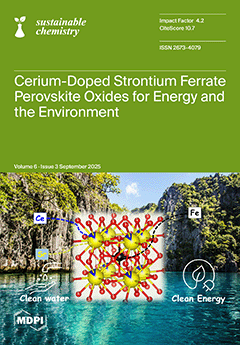2,5-bis(hydroxymethy)lfuran (BHMF), a renewable compound with extensive industrial applications, can be obtained by selective hydrogenation of the C=O group of 5-hydroxymethylfurfural (HMF), a platform molecule derived from lignocellulosic biomass. In this work, we perform kinetic modeling of the selective liquid-phase hydrogenation of HMF
[...] Read more.
2,5-bis(hydroxymethy)lfuran (BHMF), a renewable compound with extensive industrial applications, can be obtained by selective hydrogenation of the C=O group of 5-hydroxymethylfurfural (HMF), a platform molecule derived from lignocellulosic biomass. In this work, we perform kinetic modeling of the selective liquid-phase hydrogenation of HMF to BHMF over a Cu/SiO
2 catalyst prepared by precipitation–deposition (PD) at a constant pH. Physicochemical characterization, using different techniques, confirms that the Cu/SiO
2–PD catalyst is formed by copper metallic nanoparticles of 3–5 nm in size highly dispersed on the SiO
2 surface. Before the kinetic study, the Cu/SiO
2-PD catalyst was evaluated in three solvents: tetrahydrofuran (THF), 2-propanol (2-POH), and water. The pattern of catalytic activity and BHMF yield for the different solvents was THF > 2-POH > H
2O. In addition, selectivity to BHF was the highest in THF. Thus, THF was chosen for further kinetic study. Several experiments were carried out by varying the initial HMF concentration (C
0HMF) between 0.02 and 0.26 M and the hydrogen pressure (P
H2) between 200 and 1500 kPa. In all experiments, BHMF selectivity was 97–99%. By pseudo-homogeneous modeling, an apparent reaction order with respect to HFM close to 1 was estimated for a C
0HMF between 0.02 M and 0.065 M, while when higher than 0.065 M, the apparent reaction order changed to 0. The apparent reaction order with respect to H
2 was nearly 0 when C
0HMF = 0.13 M, while for C
0HMF = 0.04 M, it was close to 1. The reaction orders estimated suggest that HMF is strongly absorbed on the catalyst surface, and thus total active site coverage is reached when the C
0HMF is higher than 0.065 M. Several Langmuir–Hinshelwood–Hougen–Watson (LHHW) kinetic models were proposed, tested against experimental data, and statistically compared. The best fitting of the experimental data was obtained with an LHHW model that considered non-competitive H
2 and HMF chemisorption and strong chemisorption of reactant and product molecules on copper metallic active sites. This model predicts both the catalytic performance of Cu/SiO
2-PD and its deactivation during liquid-phase HMF hydrogenation.
Full article





